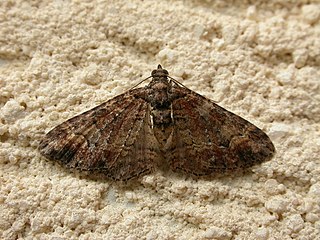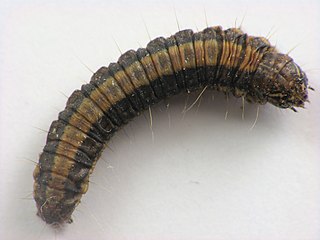
Bookworm is a general name for any insect that is said to bore through books.

Dermestidae are a family of Coleoptera that are commonly referred to as skin beetles. Other common names include larder beetle, hide or leather beetles, carpet beetles, and khapra beetles. There are approximately 500 to 700 species worldwide. They can range in size from 1 to 12 mm. Key characteristics for adults are round oval shaped bodies covered in scales or setae. The usually clubbed antennae fit into deep grooves. The hind femora also fit into recesses of the coxa. Larvae are scarabaeiform and also have setae.

Pyraustinae is a large subfamily of the lepidopteran family Crambidae, the crambid snout moths. It currently includes over 1,400 species, the majority of them tropical but some found in temperate regions including both North America and Europe.
Sphaeropteris squamulata, synonym Cyathea squamulata, is a species of tree fern native to the Malay Peninsula, Sumatra, Java, Borneo and the southern Philippines, including the Sulu Archipelago, where it grows in forest from the lowlands to an altitude of about 1500 m. The trunk is erect and up to 2 m tall. Fronds are pinnate or bipinnate and approximately 1.5 m long. The stipe is covered in densely packed firm, medium brown scales. Sori occur near the fertile pinnule midvein and lack indusia.

The Cidariini are the largest tribe of geometer moths in the subfamily Larentiinae. The Cidariini include many of the species known as "carpets" or, ambiguously, "carpet moths", and are among the few geometer moths that have been subject to fairly comprehensive cladistic study of their phylogeny. The tribe was described by Philogène Auguste Joseph Duponchel in 1845.

Omiodes is a moth genus in the family Crambidae. Several species are endemic to Hawaii.

Chrysolarentia mecynata is a species of moth of the family Geometridae. It is found in Australia.

Chrysolarentia subrectaria is a species of moth of the family Geometridae. It is found in New Zealand and Australia, including Tasmania.

Herpetogramma is a genus of moths of the family Crambidae described by Julius Lederer in 1863. It currently comprises 106 species and is found in North America, Eurasia, Australia, New Zealand, Central and South America. Of the few species where host plants are known, the larvae mostly feed on grasses.

Chrysolarentia is a genus of moths in the family Geometridae erected by Arthur Gardiner Butler in 1882. It is mainly found in Australia with one species found also in New Zealand.

Hydrelia is a genus of moths in the family Geometridae erected by Jacob Hübner in 1825.

Spargania is a genus of moths in the family Geometridae erected by Achille Guenée in 1857.

Chrysolarentia plesia, the plesia carpet, is a moth of the family Geometridae first described by Alfred Jefferis Turner in 1904. It is found in the Australian states of Victoria and Western Australia.

Xanthorhoini is a tribe of geometer moths under subfamily Larentiinae. The tribe was described by Pierce in 1914.

The Epipaschiinae are a subfamily of snout moths. Almost 600 species are known today, which are found mainly in the tropics and subtropics. Some occur in temperate regions, but the subfamily is apparently completely absent from Europe, at least as native species. A few Epipaschiinae are crop pests that may occasionally become economically significant.
William Warren was an English entomologist who specialised in Lepidoptera.
Oreta singapura is a moth in the family Drepanidae. It was described by Charles Swinhoe in 1892. It is found in Singapore, Malaysia, Indonesia and New Guinea.
Oreta unilinea is a moth in the family Drepanidae. It was described by William Warren in 1899. It is found in New Guinea, where it is known from Papua and Roon Island.
Oreta fulgens is a moth in the family Drepanidae. It was described by William Warren in 1899. It is found on Borneo, Peninsular Malaysia, the Philippines, Sulawesi, Buru and Seram.














